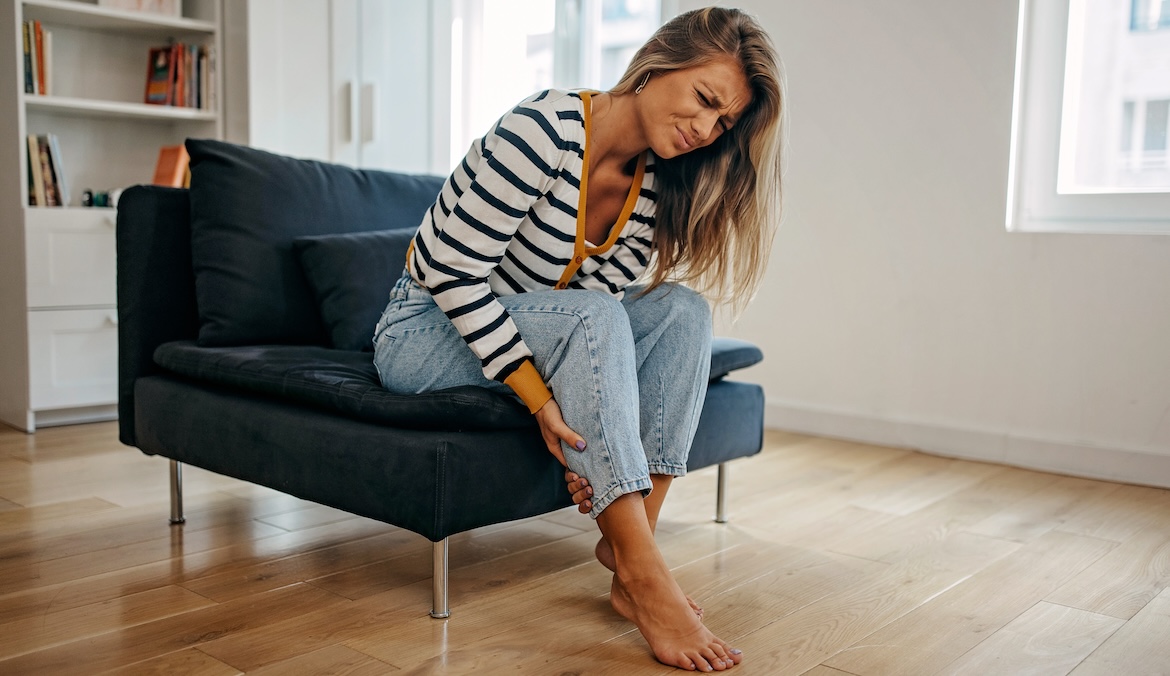Why Do My Legs Hurt *So Much* When I’m on My Period?
“Period pain is caused by many factors, and everyone experiences it differently,” says Neha Thawani, MD, an OB/GYN resident physician at Stanford Medicine. “Some people experience leg aches and pain during their period.”
A little mild leg pain during your period is normal. But in other cases, the pain can also be a sign of an underlying condition—and here are seven reasons why it might be happening.
1. Higher levels of prostaglandins
Your period leg pain might be linked to prostaglandins, which is a fancy word for the hormone-like chemicals in your body that have functions like maintaining a balance in blood clotting and regulating blood pressure. When you have your period, your body releases these chemicals to make your uterus contract (so it can shed its lining, which leads to bleeding every month). But these compounds also trigger an inflammatory response and “are responsible for symptoms like fever, chills, and pain,” Dr. Thawani says.
In other words, prostaglandins are the reason behind your crappy period cramps. “During a period, prostaglandins are often localized in the lower abdomen and pelvis, causing typical symptoms such as bloating, cramping, and nausea,” Dr. Thawani says.
OK, but why do you feel these aches and pains in your legs? This has to do with “the proximity of the uterus to the legs,” Dr. Thawani explains. “Individuals sometimes experience radiating pain.” This means that while the pain may originate in your abdomen, it can often travel to your legs.
2. Premenstrual syndrome (PMS)
Mood swings, food cravings, acne—the hallmark trifecta of premenstrual syndrome (PMS) symptoms. But, PMS is often the culprit of leg pain, too.
Premenstrual syndrome (PMS) is a group of physical and emotional symptoms that occur in some people (OK, most people) who experience periods. Research suggests that about three out of every four people who menstruate develop PMS symptoms a few days before their period starts. While PMS may be known for changes in mood or libido, joint and muscle pain is also a common PMS complaint, according to the Mayo Clinic.
3. Hormonal changes in menopause
Noticing achy legs while transitioning to menopause? There might be a reason for that. “While rare, hormonal shifts related to menopause can cause leg pain,” Dr. Thawani says. “During menopause, [estrogen] levels ultimately decline, but there are still some fluctuations, including increases in hormone release.” During this phase of life, your body can respond by secreting prostaglandins, causing an inflammatory response that can cause more aches and pains that radiate to your legs.
4. Dehydration
Dehydration is a common cause of leg cramps. During your menstrual cycle, fluctuating hormones (like estrogen and progesterone) can affect your hydration levels, as can a loss of blood (especially if your periods tend to have a heavier flow).
The problem is that a lack of water can throw off your electrolyte balance and decrease blood flow to your leg muscles, according to AARP. Both of these factors can then contribute to cramping, muscle pain, and weakness.
5. Anemia
When you don’t have enough healthy red blood cells to transport oxygen to your tissues, you can develop a common blood disorder called anemia. Some people with chronically heavy periods develop iron deficiency anemia due to excessive blood loss and depletion of iron stores over time, according to the Mayo Clinic.
Iron deficiency anemia can cause a slew of symptoms, including extreme fatigue, shortness of breath, and, you guessed it, muscle pain that can affect your legs. Anemia can trigger restless legs syndrome, a neurological disorder that gives you an irresistible urge to move your legs. You might also get sharp pains, numbness, or tingling in your lower limbs. That’s because a lack of iron can negatively affect the nervous system—the system in your body that controls and regulates pain receptors.
6. Endometriosis
“Living with endometriosis can absolutely cause leg pain during menstruation,” Dr. Thawani says. Endometriosis is a condition that occurs when tissue that is similar to the tissue that lines the uterus starts to grow outside of the uterus, leading to symptoms like pelvic pain, heavy periods, fatigue, and an increased risk of infertility.
The endometrial tissue is sensitive to hormones like estrogen and progesterone, so it will cycle through the different phases of the menstrual cycle, just like your uterus does, Dr. Thawani says. The thing is, more hormonally-sensitive tissue in your body usually means that more prostaglandins are released during your period, she adds. Because prostaglandins can increase inflammation, they’ll also likely lead to an uptick of pain that can radiate to your legs.
7. Joint pain
If you have a joint condition like arthritis, you may experience more flares while you’re going through your period. And while joint pain caused by arthritis can already cause leg pain, these aches may be more noticeable during that time of the month.
Though the connection between arthritis and the menstrual cycle isn’t totally clear, scientists hypothesize that it’s related to hormonal fluctuations (surprise, surprise), according to the Hospital for Special Surgery (HSS). One theory is that hormones can directly impact the joints by increasing inflammation. Another school of thought is that hormones can affect your pain perception. For example, some data suggest that people with uteruses feel more pain when estrogen levels are low (like right before your period), per the HSS.
When is leg pain serious?
While mildly achy legs during your period are one thing, excruciating or long-lasting leg pain is another. If your pain level is unbearable or debilitating (think: it interferes with your everyday life) and/or it persists after your period, it could be a sign of an underlying condition that needs to be checked out by your healthcare provider. At first, pain can be a nagging or uncomfortable feeling, but if you don’t get your symptoms addressed, it may lead to unwanted complications. So, don’t wait to see your provider. Let them know about your pain and they can perform tests to understand the cause and recommend treatments.
How to relieve leg pain on your period
There is some good news, though. You can usually reduce period-related leg pain with home remedies. Give these strategies a shot:
- Over-the-counter anti-inflammatory medications: Nonsteroidal anti-inflammatory drugs (NSAIDs) like Advil (ibuprofen) can often help with inflammation related to prostaglandins. For effective pain relief, take it 24 hours before your period starts, Dr. Thawani says.
- Stay hydrated: Drink at least six to eight glasses of water every day, and more if you sweat a lot. This can help prevent leg cramps related to dehydration. You can tell if you’re getting enough H2O by the color of your pee: generally (while not always), the clearer it is, the more hydrated you are. Yellow or amber-colored pee is a sign that you may need more water in your system.
- Limit alcohol and caffeine: These drinks are diuretics, which means they make you pee more often. If you’re not replenishing the lost fluids with water, drinks with caffeine and alcohol content can dehydrate you and increase the risk of pain.
- Give yourself a massage: Let yourself in on some TLC by rubbing out those cramping muscles with your hands or a foam roller for some relief.
- Move your body: Stretching, walking, and wiggling may help shake out muscle cramps, so incorporating some gentle movement is a good idea if you’re experiencing pain.
- Use a heat or ice pack: Heating pads or ice packs are known to help relieve pain at home. The HSS recommends using ice packs for acute pain or injury, while heating pads are most beneficial for muscle stiffness and cramping.
When to see a healthcare provider
Generally, leg-related period pain will reduce if you use over-the-counter medications and give your body some extra care at home during your period. But, if your pain is keeping you from your daily activities, it’s a good idea to call your healthcare provider. Remember, period-related symptoms, whether that’s leg pain, bleeding, or fatigue, should *not* interfere with your life. “If you find yourself having to call off work during your period,” get help, Dr. Thawani says. “There’s no need to suffer in silence.”
Well+Good articles reference scientific, reliable, recent, robust studies to back up the information we share. You can trust us along your wellness journey.
-
Ricciotti, Emanuela, and Garret A FitzGerald. “Prostaglandins and inflammation.” Arteriosclerosis, thrombosis, and vascular biology vol. 31,5 (2011): 986-1000. doi:10.1161/ATVBAHA.110.207449


